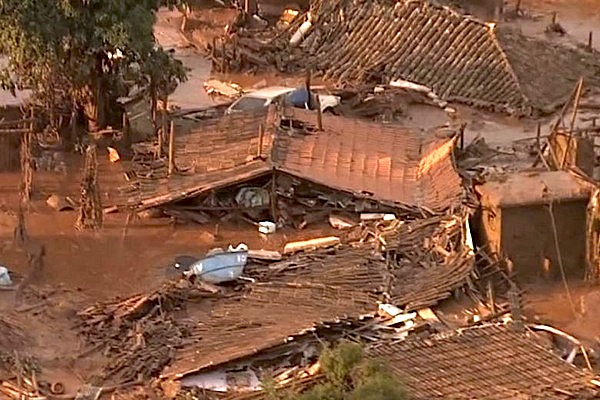Toxic elements found in water weeks after Brazil’s mine disaster — Vale

The spill has been called the biggest mining disaster in Brazil’s history, with about 20 people either confirmed dead or still missing after the dam burst sent a wave a mud cascading into a village. (Image: Screenshot of Marcelo Silva’s video via YouTube)
Toxic materials, such as arsenic, were found in the water of the Rio Doce river days after a dam burst at a mine in Brazil earlier this month, Vania Somavilla, sustainability chief at Vale (NYSE:VALE), said Friday.
Speaking at a news conference in Rio de Janeiro, Somavilla confirmed that the Institute for Water Management in Minas Gerais (IGAM) had found levels of arsenic above legal limits, local mining news outlet EM reports (in Portuguese).
IGAM found levels of arsenic, lead, aluminum, chromium, nickel and cadmium many times higher than the legal maximums at various points along the river. The tests were taken between Nov. 7 and Nov. 12, as the mud from Samarco’s dam crawled downstream, killing at least seven people, with 15 still missing.
The admission comes two days after a United Nations report alleging the presence of “high levels of toxic heavy metals and other toxic chemicals” in the river, and criticizing both the companies and the government for their “defensive” response to the accident.
But just as its joint-venture partner BHP Billiton (ASX:BHP), which yesterday released a statement reiterating that the tailings that spilled on the Rio Doce River held nothing hazardous to human health, Vale stressed that the vast amount mud unleashed on Nov.5 only contained water, soil, iron-oxide and sand, none of which are harmful.
Damage control
Biologists working along the river and coastline have been shocked by the impact of the dam burst. The mud, which has already reached the Atlantic Ocean, has killed thousands of fish and other animals in the area, but the companies have said they most likely choked to death on under the immense volume of sediment released by the dam, rather than killed by the chemical composition of the sludge.
Last week Samarco, owned by Vale and BHP, was fined 250 million reais ($65.5 million) and forced to pay for accommodations for the dispossessed.
 In a joint statement Friday, the companies announced the creation of a voluntary fund to help restore the Rio Doce basin and surrounding area.
In a joint statement Friday, the companies announced the creation of a voluntary fund to help restore the Rio Doce basin and surrounding area.
While initially sponsored by Vale and BHP, the non-profit aims to seek additional financial support from other private, public and non-government organizations. The firms did not disclose the fund’s value or what measures are planned to be put in place for the reconstruction and clean–up of the region.
The spill has been called the biggest mining disaster in Brazil’s history and has added stress on BHP and Vale, which are battling with a rout in commodities and plummeting share prices.
More News
{{ commodity.name }}
{{ post.title }}
{{ post.date }}




5 Comments
Raul Eduardo Vinas
The proposal to extract iron ore in Uruguay includes a dam with a lake ten times bigger than the one that caused the disaster in Brazil. Besides the mines are proposed in a rural area able for agriculture and cattle raising.
JH
I do not know why I am so confused. MINING.com I thought intended to present through and balanced reporting on mining, you know a place where facts mattered, but..oh well a sign of the times to stay in business I guess. Dying fish seems to be a sign of such a high sediment load, nothing with gills can get oxygen, rather then the implied arsenic etc poisoning.
Bob
I worked in the mining industry for 25 years so have a bit of understanding of the industry.
It would be interesting in actually seeing the analysis and how they were obtained to help understand the problem. For instance how high is the arsenic and is it in the silt as arsenic sulphides or is it soluble oxide form.
That said there is no excuse for the dam failure we have been seeing.
Wayne Waters
Just another sign how “humans” are destroying this wonderful Planet Earth!
Jaime Cortez Febres
As a mining engineer, knowing about construction of tailings storage facilities, I can asure that there has been a gross mistake in the design and/or construction process of the Samarco dam. Countless tailings dams around the world have been constructed for decades and, actually, with very few collapse-level incidents reported. The Samarco event has to be investigated deeply and root.causes found. Human negligence and even political corruption have to considered. Those found responsible have to go to jail and companies penalized severely for the irreparable damage to the fragile environment of the Amazon, and, more importatntly, for the unfair loss of human lifes. This sort of accidents cannot happen with current construction technologies and legislation. Shame on BHP and Vale.